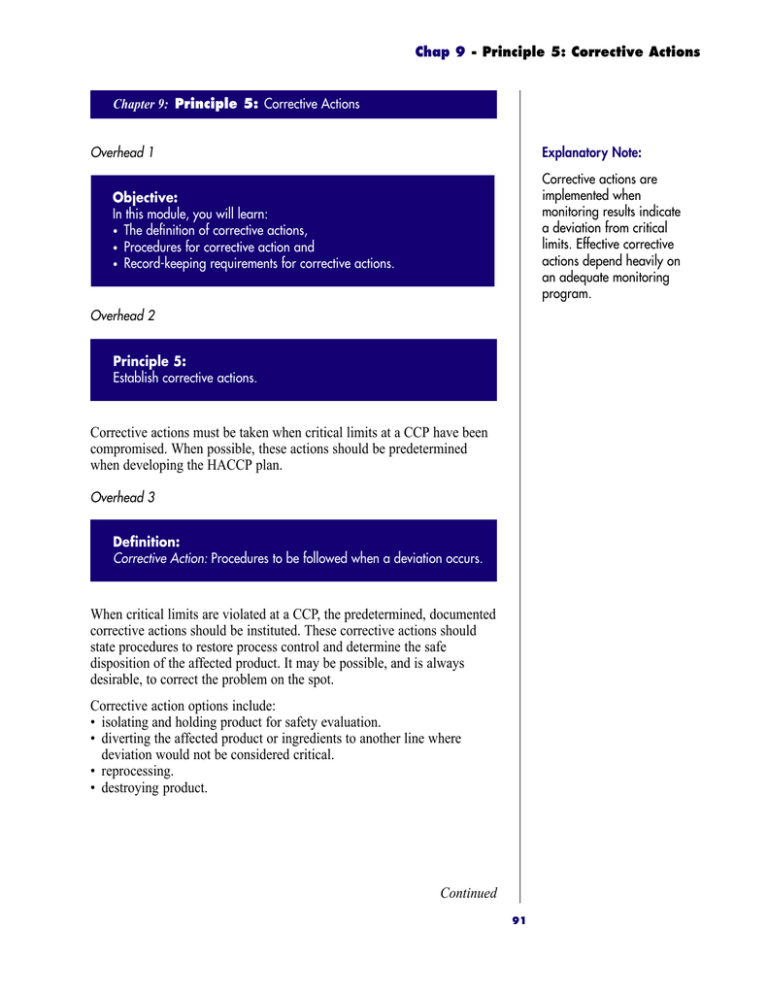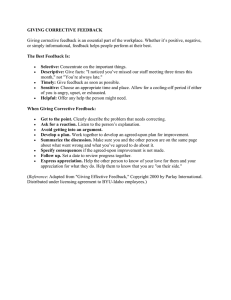Principle 5: Corrective Actions
advertisement

Chap 9 - Principle 5: Corrective Actions Chapter 9: Principle 5: Corrective Actions Overhead 1 Explanatory Note: Corrective actions are implemented when monitoring results indicate a deviation from critical limits. Effective corrective actions depend heavily on an adequate monitoring program. Objective: In this module, you will learn: • The definition of corrective actions, • Procedures for corrective action and • Record-keeping requirements for corrective actions. Overhead 2 Principle 5: Establish corrective actions. Corrective actions must be taken when critical limits at a CCP have been compromised. When possible, these actions should be predetermined when developing the HACCP plan. Overhead 3 Definition: Corrective Action: Procedures to be followed when a deviation occurs. When critical limits are violated at a CCP, the predetermined, documented corrective actions should be instituted. These corrective actions should state procedures to restore process control and determine the safe disposition of the affected product. It may be possible, and is always desirable, to correct the problem on the spot. Corrective action options include: • isolating and holding product for safety evaluation. • diverting the affected product or ingredients to another line where deviation would not be considered critical. • reprocessing. • destroying product. Continued 91 Chap 9 - Principle 5: Corrective Actions Notes: The primary objective is to establish a HACCP program that permits rapid identification of deviations from a critical limit. The sooner the deviation is identified, the more easily corrective actions can be taken and the greater the potential for minimizing the amount of noncompliant product. An individual who has a thorough understanding of the process, product and HACCP plan and who has the authority to make decisions needs to be assigned the responsibility of making corrective actions. Effective corrective action plans must: • Correct and eliminate the cause of the noncompliance to assure that the CCP is brought back under control. • Segregate, assess and determine the disposition of the noncompliant product. All corrective actions taken must be documented. Documentation will assist the firm in identifying recurring problems so that the HACCP plan can be modified. Additionally, corrective action records provide proof of product disposition. Components of Corrective Actions There are two components of corrective actions: 1) to correct and eliminate the cause of the deviation and restore process control and 2) to identify the product that was produced during the process deviation and determine its disposition. Overhead 4 Corrective Action Components: • To correct and eliminate the cause of the deviation and restore process control. • To identify the product that was produced during the process deviation and determine its disposition. • Correct and Eliminate the Cause of the Deviation and Restore Process Control Corrective actions must bring the CCP back under control. A corrective action should take care of the immediate (short-term) problem as well as provide long-term solutions. The objective is to implement a short-term fix so that control can be re-established and the process started again as soon as possible without further process deviation. 92 Chap 9 - Principle 5: Corrective Actions Notes: It may be necessary to determine the cause of the deviation to prevent future recurrence. A critical limit failure that was not anticipated or reoccurs should result in an adjustment to the product or process or a re-evaluation of the HACCP plan. One outcome of the re-evaluation may be a decision to modify the HACCP plan. A permanent solution to eliminating or minimizing the initial cause or causes for the process deviation should be implemented if necessary. Specific instructions for corrective actions must be available to plant workers and should be part of the documented HACCP plan. Explanatory Note: • Identify the Product that was Produced During the Process Deviation and Determine the Disposition If a product is to be tested and released, the sampling method is highly important. The use of a faulty sampling protocol can result in accepting, rather than rejecting, an undesirable product. The limits of sampling plans must be understood. It may be prudent to consult an expert. When a deviation occurs, identify nonconforming product. There are four steps that may be used for determining product disposition and developing a corrective action plan. Overhead 5 Four Steps: A. Step One: Determine if the product presents a safety hazard: a. Based on expert evaluation. b. Based on physical, chemical or microbiological testing. B. Step Two: If no hazard exists based on the evaluations in Step 1, the product may be released. C. Step Three: If a potential hazard exists (based on the evaluations in Step 1), determine if the product can be: a. Reworked/reprocessed. b. Diverted for a safe use. D. Step Four: If potentially hazardous product cannot be handled as described in Step 3, the product must be destroyed. This is usually the most expensive option and is usually regarded as the last resort. Explanatory Note: It is important to ensure that any reworking does not result in the creation of a new hazard. Of primary concern are toxic materials, including heat-stable biological toxins. It must be realized that reworked product is still subject to regulatory scrutiny and that reworking must result in a safe product. Continued 93 Chap 9 - Principle 5: Corrective Actions Notes: Corrective Action Format Examples Corrective actions are usually written in an “if/then” format. The “if” part of the corrective action describes the condition and the “then” part describes the action taken. For example: Overhead 6 IF deviation: Temperature of milk at pasteurizer drops below critical limit. THEN corrective action: Milk flow is diverted until temperature recovers. Diverted product is repasteurized. Check the operation of the heating/cooling units to determine the reason for the temperature deviation that caused the flow diversion. Repair if necessary, re-establish control and resume production. Overhead 7 Explanatory Note: During the process, it is possible to extend the cook time until the desired internal temperature is reached for the required time. However, this would be a “process adjustment” rather than a corrective action. IF deviation: Product (e.g., hot smoked fish) does not reach required internal temperature for the required time. THEN corrective action: Recook or destroy product. Overhead 8 94 IF deviation: Mahi-mahi held at elevated temperature for excess time period (temperature limit exceeded, possible elevated histamine level). THEN corrective action: Bury product in ice, place on hold and conduct sensory analysis and histamine test. Determine the reason for the process delay. Prevent future occurrences. Chap 9 - Principle 5: Corrective Actions Corrective Action Records Explanatory Note: Predetermined corrective actions are written into the HACCP plan. When critical limits are exceeded and a corrective action occurs, it is recorded. A corrective-action report form is helpful. The corrective action recording should be closely linked with the corresponding monitoring that recorded a deviation. Recommended approaches include recording the monitoring and corrective actions on the same form, piece of paper, or electronic record. The corrective-action report should contain the following: a. Product identification (e.g., product description, amount of product on hold). b. Description of the deviation. c. Corrective action taken including final disposition of the affected product. d. Name of the individual responsible for taking the corrective action. e. Results of the evaluation when necessary. HACCP plan records could contain a separate file in which all deviations and corresponding corrective actions are maintained in an organized fashion. Corrective actions are recorded in column 8 of the HACCP plan form. Following is the corrective actions for the IQF cooked-shrimp example. Overhead 9 HACCP Plan Form Corrective Actions: 1. 2. 3. CCP Hazard Critical Limits 4. 5. 6. 7. Monitoring What How Frequency Who 8. 9. 10. Corrective Verification Records Action(s) Specify the corrective-action procedures for each CCP. Continued 95 96 Date: Signature: Firm Address: Anywhere, USA Cook at 212 F for three minutes (to achieve minimum internal temperature of 145 F for 15 seconds) (3) Critical Limits for each Control Measure • Monitor cook time by timing the movement of a block placed on belt through cooker. Cook time • Cook time monitored hourly. • Temperature monitored continuously with hourly visual checks. Frequency (6) • Cook will perform the hourly checks. •Quality-control supervisor will program the continuousrecording thermometer. Who (7) If temperature or time parameters are not met, then processing line will be stopped and required adjustments made. All product produced during the deviation will be recooked or destroyed. (8) Corrective Action(s) Intended Use and Consumer: Thaw and serve, general public Method of Storage and Distribution: Frozen Product Description: Cooked and frozen, headless, peeled and deveined shrimp • Monitor temperature with a continuous temperature recorder How What Monitoring Cook temperature (5) (4) *Models may not be fully consistent with guidance contained in FDA’s Fish and Fishery Products Hazards and Control Guide. Survival of bacterial pathogens (2) Significant Hazards Firm Name: ABC Shrimp Co. Cooker (1) Critical Control Point (CCP) ABC Shrimp Co. Cooked Shrimp EXAMPLE: For Illustrative Purposes Only* - HACCP Plan Form (9) Verification (10) Records Chap 9 - Principle 5: Corrective Actions Allergic-type reaction from undeclared sulfiting agent Weigh/Pack Label All product containing residual sulfiting agent must declare presence (3) Critical Limits for each Control Measures • Examine all labels issued at packing line and match declaration with product identity. • Rapid sulfite test • Observation of supplier declaration • At receiving, sample each vessel of fresh shrimp to test for presence of sulfites. • At receiving, supplier declaration for absence of sulfites for frozen shrimp. How What (6) • Frozen shrimp, check every shipment • Fresh shrimp, three-grab samples per vessel • One label each time a label roll is replaced Frequency Monitoring • At weigh/pack/ label stage, check for "contains sulfite" declaration. (5) (4) • Dock master • Dock master • Packing supervisor Who (7) If this product is mislabeled, then appropriately label. (8) Corrective Action(s) (9) Verification 97 *Models may not be fully consistent with guidance contained in FDA’s Fish and Fishery Products Hazards and Control Guide. Note: In this example, results from product screening at the receiving step are a portion of the monitoring necessary to assure compliance with weigh/pack/label critical limits. (2) Significant Hazards (1) Critical Control Point (CCP) ABC Shrimp Co. Cooked Shrimp EXAMPLE: For Illustrative Purposes Only* - HACCP Plan Form (10) Records Chap 9 - Principle 5: Corrective Actions Chap 9 - Principle 5: Corrective Actions Notes: 98


